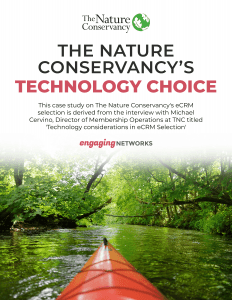This case study on The Nature Conservancy’s eCRM selection is derived from the interview with Michael Cervino, Director of Membership Operations at TNC titled ‘Technology considerations in eCRM Selection’
The Nature Conservancy (TNC), founded in 1951 is one of the largest environmental nonprofits in the Americas and worldwide. With an annual membership revenue of $75m and growing membership they faced the dilemma of staying on their current eCRM platform or upgrading to something better suited. Additionally, the organization is 4,000 staff strong around the world with chapters and layers of needs and complexity. So, how did they decide to move from their current eCRM to a new one?
Our partner in this interview is Michael Cervino, Director of Membership Operations at The Nature Conservancy. He’s had the fortune of being on multiple sides of the table when it comes to eCRM evaluation and selection having consulting at Beaconfire for many years, worked on the product side and now on the organizational side. Michael’s perspective is 360 degree and holistic.
Kathy: How long did the evaluation process take?
Michael…
An evaluation can take however long it takes. For TNC, the process started several years ago as part of Digital Transformation Strategy designed to answer the question ‘What is the future-forward technology for consumer and supporter engagement?’ What would position TNC well for the next 10-15 years?
The Nature Conservancy’s prior technology solution was older, limited and constraining. The evaluation looked at how eCRM tools fit in with the overall digital ecosystem including the website, data analysis, etc. To get the big picture. TNC decided to replace their existing eCRM with one better suited to current needs and future adaptability.
Access the PDF of The Nature Conservancy case study


There were additional decisions to be made as a result of the evaluation in regards to a ‘path choice’ – all-in-one/unified eCRM solution or choosing best-in-breed for different modules. They decided that a unified eCRM was the best solution but in a hybrid sense. They would add supplemental tools if and when needed to accompany the new eCRM – so flexibility was essential.
The Digital Transformation Strategy process took over a year. After that, the eCMR evaluation took only around three months involving over 35 stakeholders and over six prospective vendors in the process. Once they completed the ‘path choice’, the time from Request for Proposal (RFP) to signed contract moved quickly. Michael notes, this was pretty fast in his experience.
Kathy: Did you use a requirements matrix?
Michael…
Yes, with Beaconfire, the Digital Transformation Strategy resulted in functional requirements and a requirements matrix. This informed the Request for Proposal (RFP). In the RFP, they provided rules and regulations for the process, a high-level summary of needs, specific questions for vendor background – especially integration and sustaining donor migration which was a pain point on the old eCRM. In addition to the RFP, they provided the requirements matrix and asked the vendor to complete it with rankings and details.
It was about needs but also selecting a long term partner that will listen to needs, respond and grow with TNC.
Kathy: Would you suggest an RFP for any organization evaluating a nonprofit eCRM?
Michael…
That depends on if there are board or organizational requirements for selecting business partners. For TNC, contracts over a certain dollar threshold require an RFP or RFB (Request for Bid). If it’s not mandated, decide how much buy-in and support you want for this new selection. Then design your process around that.
Not sure where to start with a Requirements Matrix? No problem, we put a template together to set you in the right direction.
Creating a Request for Proposal – or RFP – can be intimidating. Our team created a details and free template to help get you started.
Kathy: As you narrowed the field, what did the team feel was very important to have?
Michael…
We designed this around an apples to apples comparison. The key that drove TNC was identifying vital decision criteria. Features, pricing, maturity and depth of functionality were certainly critical.
Each vendor got the same set of questions, then TNC would follow with unique questions if appropriate. All vendors received a specific demo script. Additionally, they asked each stakeholder to provide their most important use cases so that the vendor could respond to each. During the demo, TNC asked specifically for more product focus and less presentation – show us don’t tell us. This distinguishes real from unreal.
Really give yourself time for the demos. TNC used a multistep process, ½ day to show product plus 2 pre-scheduled follow-up sessions for more questions. Then, also, subgroup meetings were scheduled as needed. TNC communicated that up front to the vendors to set expectations about time needs from the vendor.
– Michael Cervino, Director of Membership Operations at The Nature Conservancy

This was perhaps the most important part of the decision. While TNC wanted to know that current needs were met with a new eCRM solution, they wanted to set themselves up for future success. They knew going in that nonprofit eCRMs are not wildly different. For TNC, they needed to look at now – and a year from now. What differentiated these potential eCRMs in their mind?
Michael identified several top decision factors in TNC’s choice.
The Nature Conservancy’s final decision was Engaging Networks, presumably for many of the factors identified above as well as the full suite of needed flexible modules.
Kathy: This process can be daunting. Do you have any suggestions or thoughts to pass along to anyone in the process of evaluating eCRM solutions?
Michael…
Are you planning an eCRM change or in the process of making a selection of your own? If so, check out our guides for Planning for a nonprofit eCRM Change and What to Know When Evaluating and Selecting Nonprofit eCRMs.
Engaging Networks is proud to work with exceptional organizations like The Nature Conservancy. Thank you to Michael Cervino, Director of Membership Operations for his generous time and feedback in this case study. To learn more about the amazing work of The Nature Conservancy, visit their website or watch the short video below.